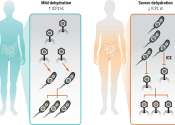Actinobacteria (high-G+C)
Firmicutes (low-G+C)
Tenericutes (no wall)
Aquificae
Bacteroidetes/Chlorobi
Chlamydiae/Verrucomicrobia
Deinococcus-Thermus
Fusobacteria
Gemmatimonadetes
Nitrospirae
Proteobacteria
Spirochaetes
Synergistetes
Acidobacteria
Chloroflexi
Chrysiogenetes
Cyanobacteria
Deferribacteres
Dictyoglomi
Fibrobacteres
Planctomycetes
Thermodesulfobacteria
Thermotogae
The bacteria [bækˈtɪərɪə] (help·info) (singular: bacterium)[α] are a large group of unicellular microorganisms. Typically a few micrometres in length, bacteria have a wide range of shapes, ranging from spheres to rods and spirals. Bacteria are ubiquitous in every habitat on Earth, growing in soil, acidic hot springs, radioactive waste, water, and deep in the Earth's crust, as well as in organic matter and the live bodies of plants and animals. There are typically 40 million bacterial cells in a gram of soil and a million bacterial cells in a millilitre of fresh water; in all, there are approximately five nonillion (5×1030) bacteria on Earth, forming much of the world's biomass. Bacteria are vital in recycling nutrients, with many steps in nutrient cycles depending on these organisms, such as the fixation of nitrogen from the atmosphere and putrefaction. However, most bacteria have not been characterized, and only about half of the phyla of bacteria have species that can be grown in the laboratory. The study of bacteria is known as bacteriology, a branch of microbiology.
There are approximately ten times as many bacterial cells in the human flora of bacteria as there are human cells in the body, with large numbers of bacteria on the skin and as gut flora. The vast majority of the bacteria in the body are rendered harmless by the protective effects of the immune system, and a few are beneficial. However, a few species of bacteria are pathogenic and cause infectious diseases, including cholera, syphilis, anthrax, leprosy and bubonic plague. The most common fatal bacterial diseases are respiratory infections, with tuberculosis alone killing about 2 million people a year, mostly in sub-Saharan Africa. In developed countries, antibiotics are used to treat bacterial infections and in agriculture, so antibiotic resistance is becoming common. In industry, bacteria are important in sewage treatment, the production of cheese and yoghurt through fermentation, as well as in biotechnology, and the manufacture of antibiotics and other chemicals.
Once regarded as plants constituting the class Schizomycetes, bacteria are now classified as prokaryotes. Unlike cells of animals and other eukaryotes, bacterial cells do not contain a nucleus and rarely harbour membrane-bound organelles. Although the term bacteria traditionally included all prokaryotes, the scientific classification changed after the discovery in the 1990s that prokaryotes consist of two very different groups of organisms that evolved independently from an ancient common ancestor. These evolutionary domains are called Bacteria and Archaea.









